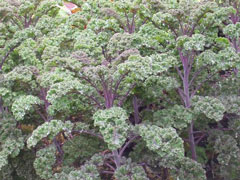


Home
Flowers &
Indoor Plants
Fruits & Nuts
Ornamentals
Vegetables
Special Topics
Resources
Glossary

Kale (Acephala Group) |
 |
What about it? Kale is a member of the mustard family. It is closely related to broccoli, cabbage, cauliflower, and turnips. What is it used for? Kale is grown for its edible leaves. These are rich in vitamins A and C as well as protein. Many varieties are very attractive and are frequently used as a garnish. Where does it grow? How do we grow it? Kale is a cool weather crop. If temperatures are much warmer than 60 degrees F, the leaves become too spicy. Kale needs plenty of water and fertilizer but will produce quickly. Lower leaves will be ready for picking 5 weeks after transplanting. What are its primary problems? Since it is in the same family as cabbage, kale is susceptible to the same pests as cabbage: cabbageworms, cabbage loopers, and cabbage root maggots. Some diseases include black rot, and downy mildew. How do we propagate it?Start your seeds indoors 5 weeks before the last frost. How do we harvest and store it? To keep your kale plants going all season, pick the lower leaves while letting the top leaves remain on the plant for photosynthetic purposes. Pick leaves when they are 5-8 inches long. However, any sized leaf is edible. If you are harvesting the entire plant there should be 12-15 large leaves on the plant. Kale is a rapid wilter and needs to be shaded and cooled immediately after harvest. Refrigeration will keep the leaves for 2 weeks.
© Copyright, Department of Horticulture, Cornell University. |



